The neighborhood of Ostia is one of Rome’s most important and yet easily forgotten districts.
Seated on the coast, just south of the airport town of Fiumicino and next to the mouth of the Tiber, the history of Ostia is as old as the city itself. Ostia Antica, now an archaeological site, was once the ancient port of Rome. However, the city lay in ruin for hundreds of years until the 19th century when Rome was made the new capital of the Kingdom of Italy. With Rome now the capital, it was obvious that a resurrection of the once great harbor was necessary.The modern neighborhood of Ostia was founded in 1884. Situated near the remains of Ostia Antica after the nearby marshland that was infested with malaria was reclaimed. The first inhabitants to settle in Nuova Ostia were peasants who came from the city of Ravenna in the northern region of Romagna. Then in the 20th century, the Via Ostiense, which was opened in 1907, connected Ostia with central Rome.
Later, the neighborhood became the favorite sea resort for the Romans after the Roma-Ostia railway was opened in 1924. Ostia underwent in greatest expansion during the Fascist period as the government envisioned it being Rome’s front doorstep. Another road, the Via del Mare’, was built during this period along the promenade and a water airport.
It wasn't until after World War 2 however that the neighborhood experienced a real boom in tourism. This was largely due to many bathing establishments being built along the seaside, adding to the appeal of the neighborhood. Yet another road was also built, the Cristoforo Colombo Avenue, to connect Ostia with the district of EUR in Rome. The influx of tourism did not last long as the popularity of Ostia quickly dropped due to sea pollution which became apparent during the 1970s. It was during this same decade, in 1976, that Ostia officially became a part of the X Municipio of the comune of Rome.
Today, Ostia is home to around 230,000 people. If it were its own city, it would be the 14th largest in the entire country. However, while locals may flock to the beaches on hot days, the neighborhood still sees little in terms of tourism. Although the quality of the beaches has improved, it still hasn't managed to attract the same kind of popularity that it did during the post-war years. Considering it is the closest beach to Rome, one of the most popular tourist destinations in Europe, it seems surprising that Ostia would remain somewhat forgotten. This begs the question as to why, and while it certainly can't be down to one thing, in particular, the influence of the mafia certainly has a huge part to play.
Who are the Spada?
While they are not the only criminal organization in the neighborhood of Ostia, they have been perhaps the most powerful for the last decade, having risen to prominence after another criminal organization, known as the Fascians, were all but wiped out. Originally from Abruzzo, the Spada are a large family of Sinti that arrived in Rome during the 1950s. Investigations over the years have revealed that the heads of the family also act as leaders of the criminal organization. They have been known to extort protection money from local traders, intimidate other criminal groups, and manage the allocation of public housing. In addition, the Spada also controls several gyms in Nuova Ostia, which have long been free for local youth to attend. This is perhaps the best example of how the clan maintains control over the local population. Nuova Ostia is a neighborhood made up of very underprivileged and largely public housing. Many people who live in the neighborhood do not have jobs and therefore have no source of income. The Spada exploit this by offering to help those in need by effectively replacing the state. They have become a mix of benefactors and torturers. Helping those in need while violently and ruthlessly disposing of those who oppose them. The Spadas are associated with the Casamonica clan, the most powerful and well-established criminal organization in the region of Lazio with estimated assets amounting to around 90 million euros. Around a dozen members of the Spada family and their allies have been sentenced since 2016. This includes an incident in 2017 when Roberto Spada, one of the top members of the family, attacked a journalist for asking questions about the Spadas links to neo-fascist organization CasaPound. Roberto Spada was sentenced to life imprisonment in January of 2021.Who is CasaPound?
CasaPound is a neo-fascist movement and former political party that was founded in 2003. Over the past few years, investigators have noticed an increasingly close relationship between members of the Spada family and CasaPound. The relationship started when CasaPound began distributing food packages in the poorest neighborhoods, such as Nuova Ostia, something the Spada family had been doing for years.
Roberto Spada even openly supported Luca Marsella, the CasaPound candidate for the Municipality of Ostia. According to several newspapers, on the day of the vote, the polling stations were manned by CasaPound activists and friends of the Spada family. They received more than 20 percent of the votes in Nuova Ostia.
Mafia Capitale
To be specific, the only “true” mafia organizations in the country are Cosa Nostra in Sicily, ‘Ndrangheta in Calabria, and Camorra in Campania. Other criminal organizations don’t fall into the same category, though they do operate in a similar fashion to these groups. However, in 2015 Andrea Tassone, PD president of Municipio X, was involved in the Mafia Capitale investigation for having done favors for Salvatore Buzzi, one of the bosses of the group.The investigation into the Mafia Capitale was sparked by Rome's chief prosecutor, Guiseppe Pignatone, who uncovered a wide network of corrupt relationships between some politicians and criminal organizations in the capital. The criminal actions of the group centered around the recent influx of migrants to Italy, who took advantage of the situation by gaining public contracts to manage the migrant reception centers. They also used their connections to secure lucrative public contracts, before accepting payments for substandard, or sometimes nonexistent services. Those investigated include former mayor Gianni Alemanno as well as bosses Salvatore Buzzi and Massimo Carminati. Carminati is a former member of the neo-fascist militant organization Nuclei Armati Rivoluzionari and the Banda della Magliana.
Members of the Calabrian mafia organization 'Ndrangheta were also tried. The former president of Ostia was among those arrested in 2014 when a 1200-page arrest warrant was issued. This is one of the only times that a real mafia influence has been detected in the neighborhood of Ostia. The events of the Mafia Capitale investigation are the basis for the 2015 film Suburra, and the 2017 Netflix series Suburra: Blood on Rome.
Is the Mafia present in Ostia?
In the city, no one has ever been convicted of a mafia-type criminal association, but have received sentences because of the use of mafia methods. According to many, this signals that a climate of fear, silence, and intimidation has been created. Everyone knew who they had to respect and what the consequences were if they crossed those in charge. In recent years there have been frequent intimidation and arson attacks against those who were not willing to pay the protection money, or who crossed a ruling family in some other way.While the Spada clan have reigned supreme in Ostia more recently, the criminal groups that have ruled over f the city have changed often over the years. This rapid turnover is the result of clashes between various factions as well as arrests of many prominent members. At the beginning of this last decade, the heirs of Banda della Magliana, the largest and most powerful criminal organization which commanded the city and whose influence was particularly strong during the late seventies and early eighties, had control over Ostia. Their influence however diminished, especially after two of their members, Francesco "Sorcanera" Antonini and Giovanni "Baficchio" Galleoni, were killed in an ambush in broad daylight in the center of Ostia in 2011.
The murder of Antonini and Galleoni signaled the end of the most violent phase of the struggle for power over the city, which began in the early 2000s. After the Banda della Magliana, the Triassi took power over the city, followed by the Fascians, who were severely hit by a series of arrests in 2013. Then, finally, we arrive at the Spadas, the latest to take power. Official investigations show that they rose to significant power in 2013, around the same time that the Fascians fell. However, after reaching the height of their national notoriety, the family's power seems to have entered a downward phase.This is largely due to the attention brought to them by the Roberto Spada incident and the 32 arrests made during operation "Eclipse" in January of 2018. The question is then, how long will the Spadas grip on power last, and when they do inevitably fall, as so many others have before them, who will take their place? One thing is certain though, whoever takes power next, Ostia will be a crucial part of the bid for power over the city. The neighborhood on the coast which has seemingly been left to its own devices by the authorities has long been the center of the struggle for power over the city.
General Info
View on Map
Why does Ostia remain somewhat forgotten?
Lido di Ostia RM, Italia


















